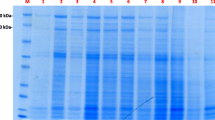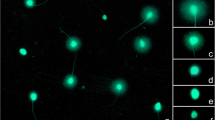Summary
Interferometric dry mass and microspectrophotometric DNA and arginine determinations were carried out on 4000 sperm nuclei from 85 bulls. The results obtained are as follows:
-
1.
Spermatozoa containing a constant haploid amount of DNA (3.04 × 10−9 mg.) also have a constant arginine content of 2.07 × 10−9 mg. with a DNA/arginine ratio of 1.47.
-
2.
Spermatozoa containing variable and low amounts of DNA also have variable and usually higher amounts of arginine with a ratio of 0.95 for DNA/arginine.
-
3.
However the dry mass of sperm nuclei with an abnormal DNA content is nearly the same as the dry mass of sperm nuclei with the normal haploid DNA content. The dry mass for each group is 7.3 × 10−9 mg. and 7.1 × 10−9 mg. respectively.
-
4.
On the basis of the DNA, arginine and dry mass data, a protein content of 4.06 × 10−9 mg. containing 50% arginine can be computed for normal bull sperm nuclei.
Similar content being viewed by others
References
Avery, O. T., C. M. MacLeod andM. McCarty: Studies on the chemical nature of the substance inducing transformation of pneumococcal types. Induction of transformation by a desoxyribonucleic acid fraction isolated from pneumococcus type III. J. of Exper. Med.79, 137–157 (1944).
Baker, C.: The Baker interference microscope. London: Holborn 1954.
Barer, R.: Interference microscopy and mass determination. Nature (Lond.)169, 366–367 (1952).
—: Phase-contrast, interference contrast, and polarizing microscopy. Analytical Cytology. New York: The Blakiston Division, McGraw-Hill Book Co. 1955.
Beadle, G. W.: What is a gene? Amer. Inst. Biol. Sci.5, 15 (1955).
Chapman, L. M., D. M. Greenberg andC. L. A. Schmidt: Studies on the nature of the combination between certain acid dyes and proteins. J. of Biol. Chem.72, 707–729 (1927).
Davidson, J. N.: The biochemistry of the nucleic acids. New York: John Wiley & Sons 1953.
Davies, H. G., M. H. F. Wilkins, J. Chayen andL. F. La Cour: The use of the interference microscope to determine dry mass in living cells and as a quantitative cytochemical method. Quart. J. Miorosc. Sci.95, 271–304 (1954).
Deitch, A. D.: A Microspectrophotometric study of the binding of the anionic dye, naphthol yellow S by tissue sections and by purified proteins. Laboratory Invest.4, 324–351 (1955).
Fraenkel-Conrat, H., andM. Cooper: The use of dyes for the determination of acid and basic groups in proteins. J. of Biol. Chem154, 239–246 (1944).
Hershey, A. D.: Functional differentiation within particles of bacteriophage T2. Cold Spring Harbor Symp. Quant. Biol.18, 135–139 (1953).
Leuchtenberger, C.: A cytochemieal study of pycnotic nuclear degeneration. Chromosoma3, 449–473 (1950).
—: The nucleoproteins in cell growth and division. Statistics and mathematics in biology. Ames, Iowa; Iowa State College Press 1954.
—: Critical evaluation of Feulgen microspectrophotometry for estimating amount of DNA in cell nuclei. Science (Lancaster, Pa.)120, 1022–1023 (1954a).
Leuchtenberger, C., G. Klein andE. Klein: The estimation of nucleic acids in individual isolated nuclei of ascites tumors by ultraviolet microspectrophotometry and its comparison with the chemical analysis. Cancer Res.12, 480–483 (1952).
Leuchtenberger, C., R. Leuchtenberger andA. M. Davis: A microspectrophotometric study of the desoxyribose nucleic acid (DNA) content in cells of normal and malignant human tissues. Amer. J. Path.30, 65–85 (1954).
Leuchtenberger, C., R. Leuchtenberger, F. Schrader andD. R. Weir: Reduced amounts of desoxyribose nucleic acid (DNA) in testicular germ cells of infertile men with active spermatogenesis. Laboratory Invest. 1956.
Leuchtenberger, C., R. Leuchtenberger, C. Vendrely andR. Vendrely: The quantitative estimation of desoxyribose nucleic acid (DNA) in isolated individual animal nuclei by the Caspersson ultraviolet method. Exper. Cell Res.3, 240–244 (1952).
Leuchtenberger, C., andF. Schrader: Exceptional desoxyribose nucleic acid (DNA) findings in a sterile dwarf bull. J. Biochem. a. Biophys. Cytology1956.
Leuchtenberger, C., F. Schrader, D. R. Weir u.D. P. Gentile: The desoxyribose nucleic acid (DNA) content in spermatozoa of fertile and infertile human males. Chromosoma6, 61–78 (1953).
Leuchtenberger, C., R. Vendrely andC. Vendrely: A comparison of the content of desoxyribose nucleic acid (DNA) in isolated animal nuclei by cytochemical and chemical methods. Proc. Nat. Acad. Sci. U.S.A.37, 33–38 (1951).
Leuchtenberger, C., D. R. Weir, F. Schrader a.R. Leuchtenberger: Abnormal amounts of desoxyribose nucleic acid (DNA) in germ cells of human males with suspected infertility. Excerpta med., sec. I9, 418 (1954).
Mann, T.: The biochemistry of semen. New York: John Wiley & Sons 1954.
Mazia, D.: The particulate organization of the chromosomes. Proc. Nat. Acad. Sci. U.S.A.40, 521–527 (1954).
Mel-Lors, R. C.: The quantitative analysis of the cell by interference and ultraviolet microscopy. Texas Rep. Biol. a. Med.11, 693–708 (1953).
Mellors, R. C., andJ. Hlinka: Quantitative cytology and cytopathology. IV. Interferometric measurement of the anhydrous organic (dry weight) of genetic material in sperm nuclei of the mouse, the rat and the guinea pig. Exper. Cell Res.9, 128–134 (1955).
Pollister, A. W.: Quelques méthodes de cytologie chimique quantitative. Rev. d'Hématol.5, 527–554 (1950).
Pollister, A. W., andM. J. Moses: A simplified apparatus for photometric analysis and photomicrography. J. Gen. Physiol.32, 567–577 (1949).
Schrader, F., andC. Leuchtenberger: A cytochemical analysis of the functional interrelations of various cell structures inArvelius albopunctatus (DE Geer). Exper. Cell Res.1, 421–452 (1950).
Swift, H. H.: Quantitative aspects of nuclear nucleoproteins. Internat. Rev. Cytology2, 1–76 (1953).
Vendrely, R., andC. Vendrely: Arginine and deoxyribonucleic acid content of erythrocyte nuclei and sperms of some species of fishes. Nature (Lond.)172, 30–31 (1953).
Author information
Authors and Affiliations
Additional information
This investigation was supported (in part) by research grant A-787 from the National Institutes of Health, U.S. Public Health Service, and in part by the Franchester Fertility Fund of Cleveland, Ohio.
Rights and permissions
About this article
Cite this article
Leuchtenberger, C., Murmanis, I., Murmanis, L. et al. Interferometric dry mass and microspectrophotometric arginine determinations on bull sperm nuclei with normal and abnormal DNA content. Chromosoma 8, 73–86 (1956). https://doi.org/10.1007/BF01259494
Received:
Issue Date:
DOI: https://doi.org/10.1007/BF01259494




